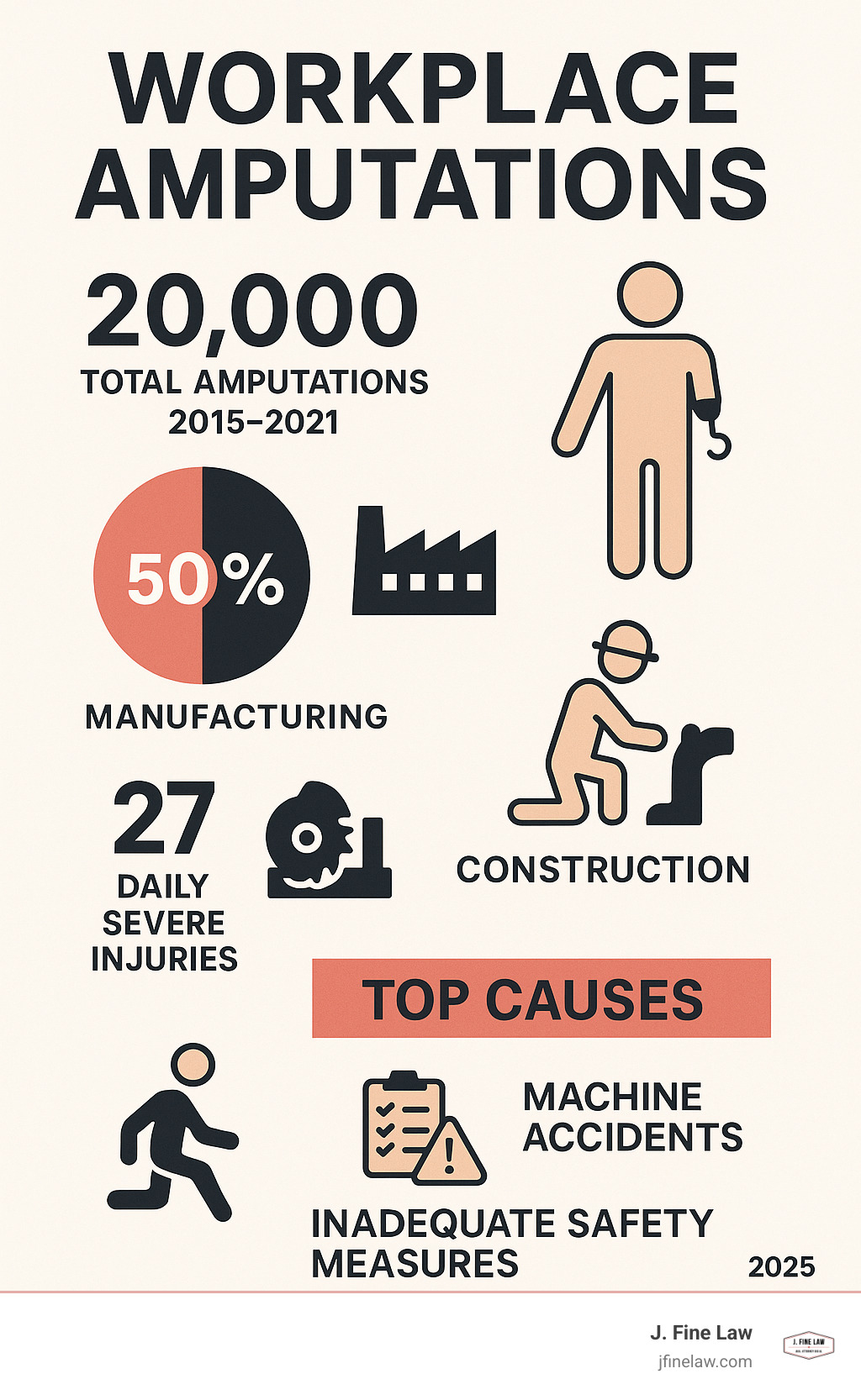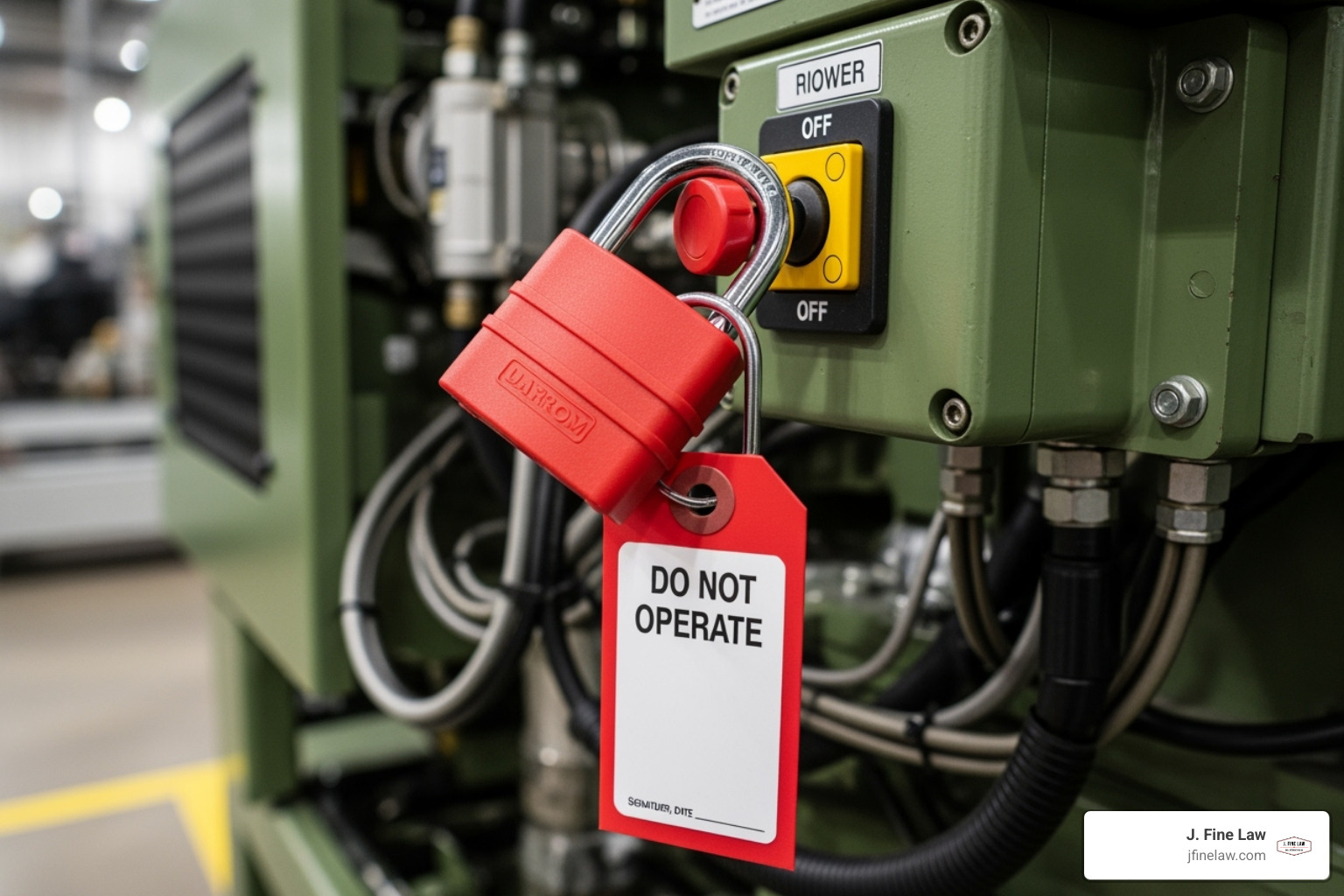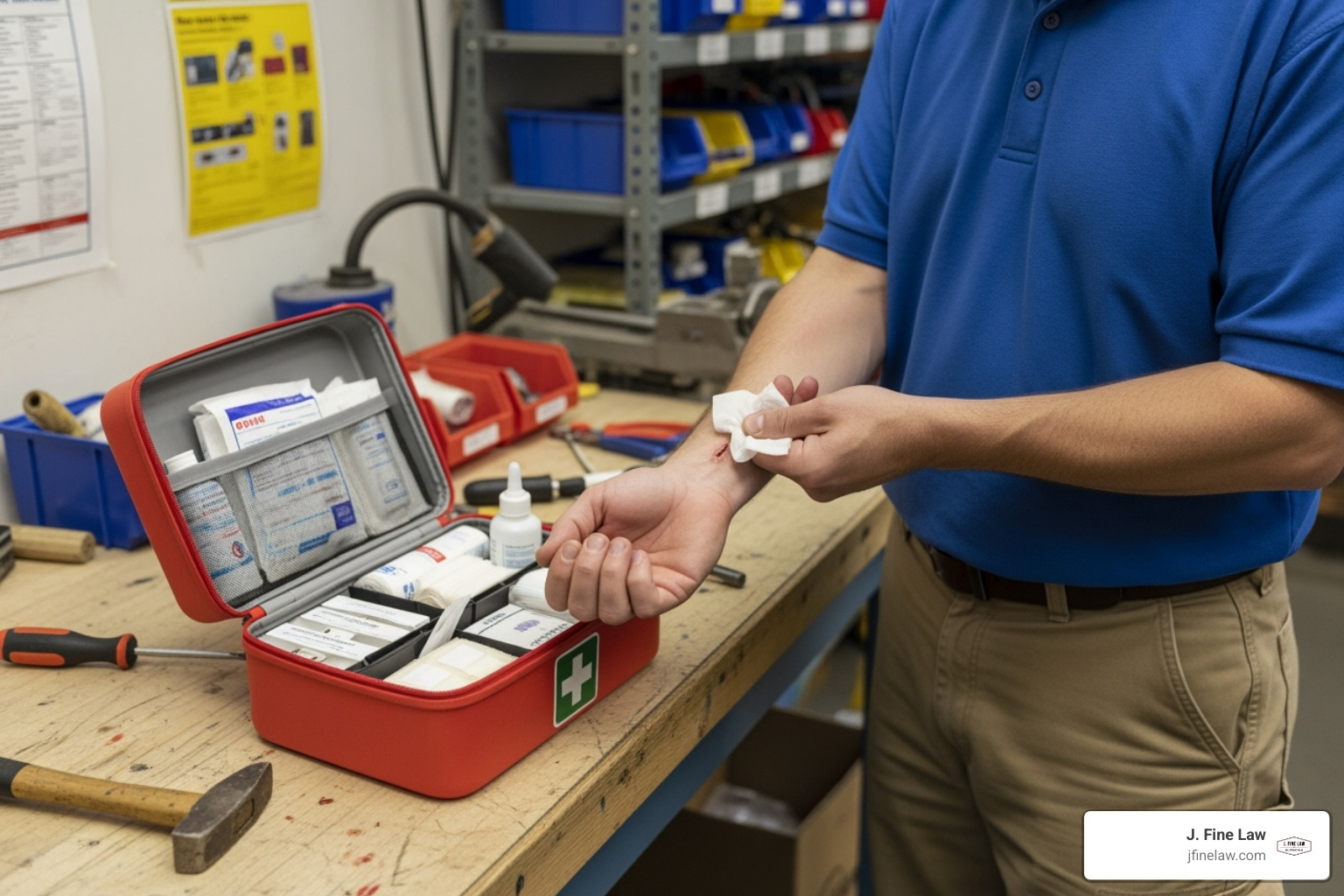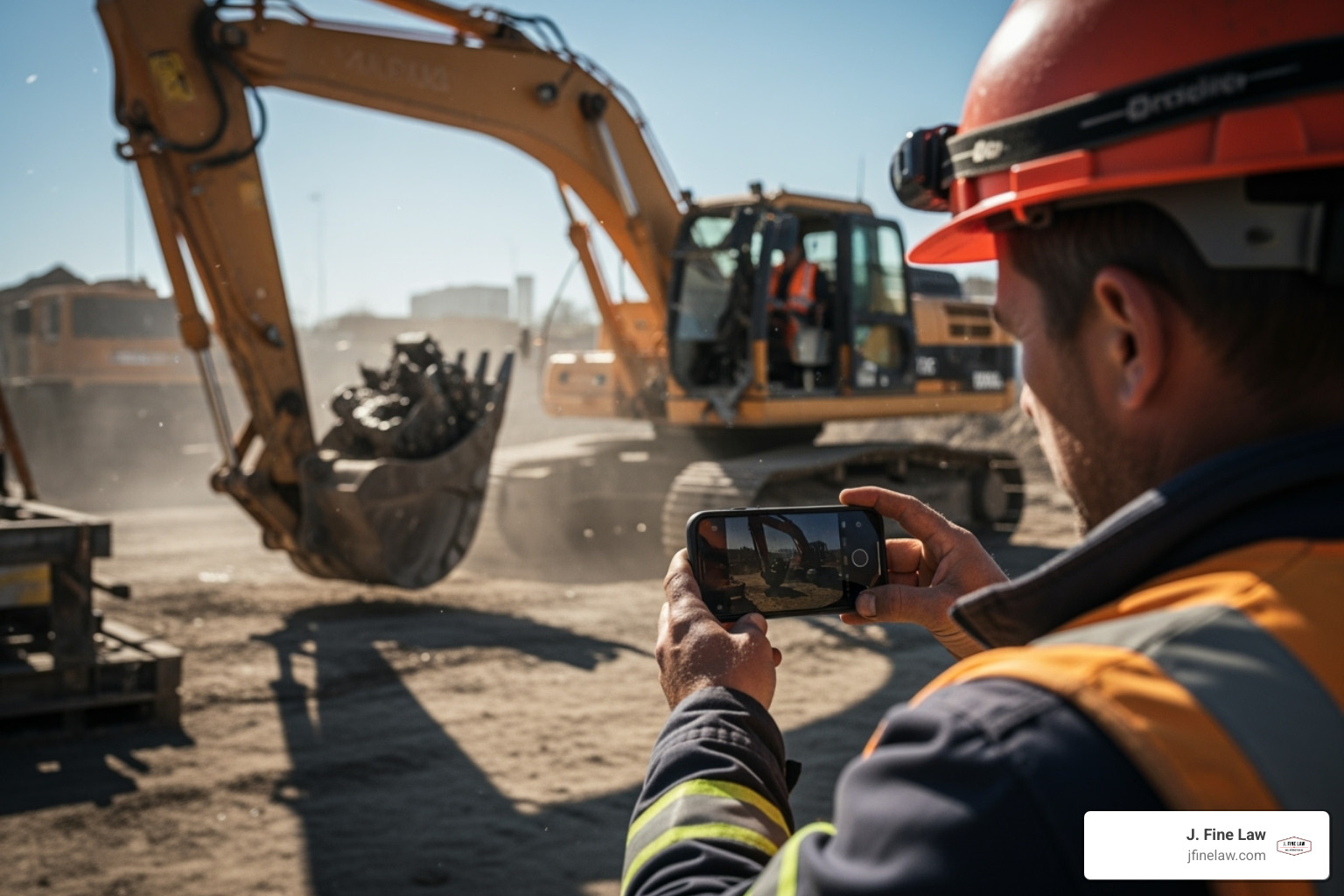The Reality of Workplace Amputations: Causes, Risks, and Prevention
An amputation work injury represents one of the most devastating workplace accidents that can forever change a worker’s life. These catastrophic injuries don’t just affect the physical body – they impact earning capacity, emotional well-being, and family stability for years to come.
Key Facts About Amputation Work Injuries:
- Nearly 20,000 workplace amputations occurred from 2015-2021 according to OSHA
- Manufacturing accounts for 50% of all workplace amputations
- Construction represents 10% of amputation injuries
- 27 workers daily experience severe injuries including amputations
- 5,049 amputations required hospitalization between 2015-2021
The statistics paint a sobering picture. Manufacturing, construction, and agriculture remain the highest-risk industries, with machinery accidents being the leading cause. Most of these injuries stem from preventable causes like inadequate machine guarding, poor training, or lockout/tagout failures.
What makes amputation injuries particularly challenging is their permanent nature. Unlike broken bones that heal, losing a limb means adapting to phantom pain, learning to use prosthetics, and often retraining for entirely new careers. The financial burden extends far beyond initial medical bills to include ongoing rehabilitation, specialized equipment, and reduced earning capacity.
The good news? Pennsylvania and New Jersey workers have strong legal protections through workers’ compensation systems designed specifically for these catastrophic injuries. Understanding your rights from day one can mean the difference between struggling financially and securing the resources needed for recovery.
I’m Jason Fine, a Pennsylvania Super Lawyer with over 25 years of experience representing workers who’ve suffered severe injuries, including amputation work injury cases. My team at J. Fine Law has secured millions in compensation for injured workers, fighting insurance companies that often try to minimize these life-changing claims.
Common Causes and High-Risk Industries
Workplace amputations are rarely random; they typically result from specific, preventable hazards.
The most common causes include:
- Machine Accidents: The leading cause, where limbs are caught, crushed, or entangled in equipment like power presses, conveyors, food slicers, and grinders, whose power can cause instant, devastating injury.
- Lack of Safeguards: Missing, improperly installed, or removed machine safeguards create extreme risk. These guards are physical barriers designed to prevent contact with dangerous moving parts.
- Inadequate Training: Insufficient training on safe machine operation and emergency procedures significantly increases the risk of an amputation work injury.
- Human Error: Fatigue, distraction, or misjudgment can lead to tragic accidents even with proper training and safeguards.
- Lockout/Tagout Failures: These occur when procedures to de-energize machinery during maintenance are ignored or faulty, leading to unexpected startups and severe injuries.
- Hand Tool Misuse: Both powered and non-powered hand tools can cause amputations if used improperly or if they are defective.
- Slip and Fall Accidents: A severe fall can lead to an amputation if a limb is crushed or severed by equipment during the fall.
Certain industries are more prone to these injuries due to the nature of their work:
- Manufacturing Sector: Accounting for over 50% of amputations, this sector’s high-speed machinery and automated processes pose significant risks.
- Construction Industry: This industry accounts for 10% of amputations due to heavy equipment, power tools, and the constant movement of materials.
- Agriculture: Powerful machinery like tractors and harvesters can lead to severe limb injuries.
- Meat Processing: Specialized cutting and grinding equipment in this industry can easily cause amputations if not properly guarded or operated.
- Other sectors: Other sectors reporting amputations include retail, transportation, forestry, and mining, showing these injuries can happen in many environments.
Employer’s Role in Prevention and OSHA Reporting
Employers have a legal and moral duty to provide a safe work environment, which is the primary way to prevent an amputation work injury. A commitment to safety drastically reduces the risk of these accidents.
Key employer responsibilities include:
- Machine Guarding: Employers must install and maintain guards on all hazardous machinery. These physical barriers prevent contact with moving parts and must not be easily removed or bypassed.
- Lockout/Tagout Procedures: Strict lockout/tagout procedures are crucial to ensure machinery is de-energized during maintenance or cleaning. All relevant employees must be trained on these protocols.
- Safety Training: Comprehensive, ongoing, and job-specific training is vital. It must cover safe machine operation, hazard recognition, and emergency procedures.
- Personal Protective Equipment (PPE): Employers must provide and ensure the use of appropriate PPE. However, PPE is a supplement to, not a substitute for, proper machine guarding.
- Regular Inspections and Maintenance: Regular equipment inspections are necessary to identify and fix defects or missing safeguards promptly.
- Promoting a Safety Culture: Fostering a culture where safety is prioritized and employees can report hazards without fear of reprisal is key.
OSHA requires employers to report severe work-related injuries:
- A fatality must be reported within 8 hours.
- An in-patient hospitalization, amputation, or loss of an eye must be reported within 24 hours.
This reporting allows OSHA to investigate incidents, identify patterns, and enforce safety standards. You can find more details in the OSHA Annual Report on Severe Injuries.
The Long-Term Impact of an Amputation Work Injury
An amputation work injury carries an immense and lasting physical and emotional toll. It’s a life-altering event that affects every aspect of a person’s existence.
The financial impacts are staggering and lifelong. Costs include emergency care, multiple surgeries, hospital stays, and medications. Long-term burdens are even more substantial, including prosthetics that cost tens of thousands and require regular replacement, extensive physical and occupational therapy, and mental health counseling.
Lost earning capacity is one of the most devastating impacts. Many workers in physical jobs like construction or manufacturing cannot return to their roles. This often requires vocational retraining for a new, potentially lower-paying career.
Beyond the financial strain, the emotional and psychological impacts are equally challenging:
- Phantom Limb Pain: Many amputees experience this real, often debilitating neurological phenomenon, which requires specialized treatment.
- Emotional Trauma: The shock, grief, and depression following an amputation are profound, as individuals struggle with loss and a diminished sense of self.
- Psychological Support: Support from family, friends, and mental health professionals is critical for coping and adapting.
- Adaptation Process: Adapting is a continuous process involving physical healing, learning to steer the world differently, and deep psychological adjustment.
These long-term impacts underscore why an amputation work injury demands comprehensive support and compensation, far beyond just initial medical bills.
Navigating the Aftermath of an Amputation Work Injury
When an amputation work injury happens, those first moments feel like everything is spinning out of control. Your world just changed forever, and you’re trying to process something that seems impossible. But here’s what I want you to know: the steps you take right now can make an enormous difference in your recovery and your family’s future.
I’ve walked alongside hundreds of workers through this exact situation. The chaos is real, the fear is overwhelming, and you’re probably wondering how you’ll ever get through this. You will – and you don’t have to figure it out alone.
Critical First Steps After an Accident
In the crucial moments after an amputation work injury, your actions can save your life and protect your future. Here are the critical steps:
Get medical help immediately. This is non-negotiable. Call 911 and apply firm pressure to the wound to control bleeding. Every second counts to prevent life-threatening blood loss and preserve the limb.
Preserve the severed limb if possible. Proper preservation can make reattachment possible. Wrap the severed part in a clean, damp cloth, place it in a sealed plastic bag, and put the bag in ice-cold water. Do not let the limb directly touch ice.
Tell your supervisor immediately. Ensure your employer is contacted right away, even from the ambulance. Prompt reporting prevents disputes about the injury occurring at work. Do not let shock or pain cause a delay.
Document everything you can. If possible, have someone take photos of the accident scene, the machinery involved, and any safety hazards. Get names and contact information from all witnesses, as their testimony is crucial.
Start keeping detailed records from day one. Document every doctor visit, medication, and conversation with your employer. This record is vital when dealing with insurance companies.
Securing Workers’ Compensation for an Amputation Work Injury
Workers’ compensation is a no-fault system designed for injuries like yours. You only need to prove the injury happened at work. For an amputation work injury, these benefits are critical for financial survival.
For workers’ comp, an amputation is the severance of a body part. For Permanent Partial Disability benefits, a doctor may need to confirm the percentage of limb function lost, though losing an entire hand or foot qualifies for significant benefits due to the profound impact.
Medical benefits cover all related costs: emergency care, surgeries, hospital stays, medication, physical and occupational therapy, mental health counseling, prosthetics, and adaptive medical equipment.
Wage loss benefits replace about two-thirds of your average weekly pay while you cannot work. These benefits may continue if you are permanently unable to return to your job.
Permanent Partial Disability benefits provide separate compensation for the permanent impact on your life. A doctor rates your impairment based on factors like age, health, and skills; we can fight a rating you disagree with.
Filing your claim properly starts with an immediate report to your employer. They should file the claim, but if they don’t or if benefits are denied, we file a formal claim petition. Deadlines are strict: three years in Pennsylvania and two years in New Jersey.
The insurance companies make money by paying you as little as possible. Our team at J. Fine Law handles all the paperwork, meets every deadline, and fights for every dollar you deserve. We know the system inside and out, and we’ve secured over $50 million for injured workers. You can learn more about your rights on our Workplace Accidents in Pennsylvania page.
Protecting Your Rights and Future
After an amputation work injury, you are vulnerable. Employers and insurers know this, and some may try to take advantage. It’s crucial to understand how to protect yourself.
Your job protection has limits. While your employer cannot fire you for filing a workers’ comp claim (which is wrongful termination), they aren’t required to create a new position for you. If you cannot perform your old job’s duties after reaching Maximum Medical Improvement, they may let you go if no other suitable positions are available.
In New Jersey, employers with 50+ employees must give you hiring preference for suitable, existing positions after you reach maximum medical improvement. They don’t have to create jobs, but must offer you openings you qualify for. The Americans with Disabilities Act (ADA) also requires employers to provide reasonable accommodations to help you perform your job, unless it creates an undue hardship for them.
Time limits are critical. Missing them can cost you everything. In New Jersey, you must report your injury within 90 days and file a claim within two years. In Pennsylvania, you have 120 days to report and three years to file. These are hard deadlines. If a third party, like a machine manufacturer, caused your injury, you may have a separate personal injury claim. These also have strict deadlines, typically two years in NJ and PA.
An experienced attorney is your lifeline. Insurance companies have lawyers dedicated to minimizing your payout. You need an expert in your corner who knows their tactics and will fight for you. At J. Fine Law, we handle everything: navigating the claims process in PA and NJ, gathering evidence, fighting for maximum benefits, appealing denials, and protecting you from wrongful termination. We also investigate third-party liability to open additional avenues for compensation.
Our 98% success rate isn’t luck – it’s preparation, experience, and refusing to settle for less than you deserve. We offer rapid attorney response because we know you can’t wait weeks for answers when your family’s future is on the line.
You’ve already been through enough. Don’t face the legal battle alone. Contact our team for a free case evaluation. We’re here to fight for your future, and you can reach us at Contact a Workplace Accident Lawyer in New Jersey.




